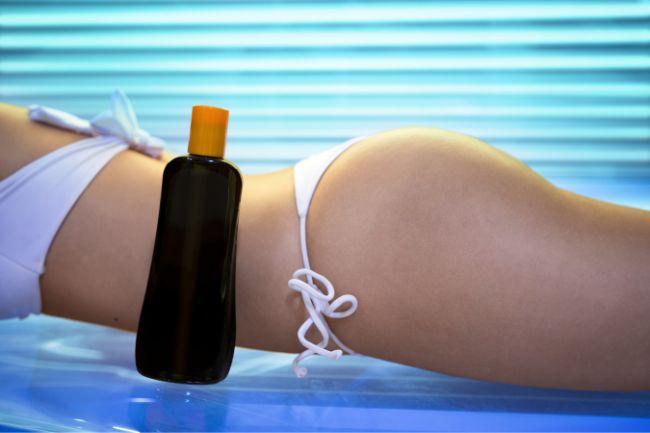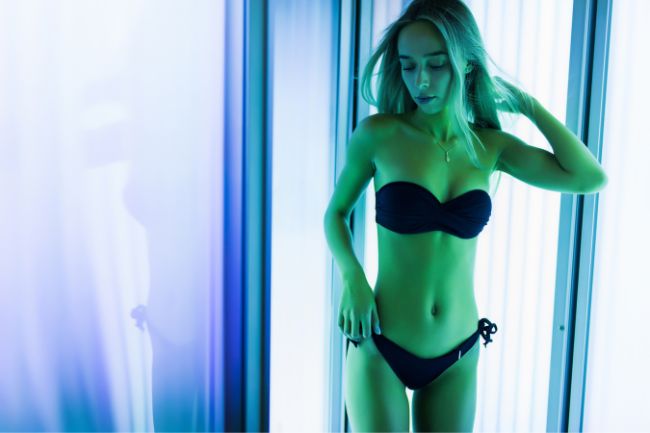Tanning bed lotions are specifically designed for use in indoor tanning beds and may not provide adequate protection against the sun’s harmful UV rays when used outside. It is recommended to use sunscreen with appropriate SPF for outdoor tanning to ensure proper sun protection and reduce the risk of sunburn and skin damage.
What is tanning bed lotion?

Before we begin, it’s helpful to know what tanning bed lotion is, especially if you’re not very experienced in the world of sunbeds and tanning. When you use an indoor sunbed, you expose your skin to artificial UV rays, similar to those emitted by the Sun, which promote the production of melanin in your skin, giving you a summer bronze.
However, just like sunbathing outdoors, it’s important to protect your skin from the UV rays inside a tanning bed, which is where a tanning bed lotion comes into practice. The job of this product is to protect your skin from these rays, as a normal sunscreen would, but it’s made up of a slightly different formula to increase its efficiency in the sunbed.
Also read: What Is Sunscreen Made Of? (Common Ingredients)
How does tanning bed lotion work?
Now that we understand a basic idea of what a tanning bed lotion is, it’s time to take a look at how these products work, as they’re not like your typical sunscreen for outdoor sunbathing.
For those unfamiliar with the tanning bed experience, it’s a little different to regular sunbathing, and involves a much more intense concentration of UV rays than outside, and these work on your skin for a short period of time. Therefore, a tanning bed lotion is designed for these short, more intense tanning experiences, as opposed to a regular sunscreen, which is designed for long exposure times.
When using an indoor sunbed, the main goal is to reach a dark, tanned complexion all over the body in a short time, so the aim of a tanning bed lotion is to increase melanin production. Melanin is the pigment found in your skin, produced by melanocytes (small structures below the skin’s surface), which darkens your skin tone.
In addition to this, some tanning bed lotions also contain bronzing agents, including DHA (dihydroxy acetone), which is used in most self-tanning products as it binds to the skin. giving it an instant tan.
Also read: Best Moisturizers to Use After the Tanning Bed (Face & Body)
Does tanning bed lotion work outside?

Tanning beds seem to yield better results in terms of skin tone, so is it time to try swapping your regular sunscreen for a tanning bed lotion instead?
Generally, you’ll probably find that most tanning bed lotions will be labelled that they aren’t suitable for outdoor use, and there are a few reasons for this. The main reason for this is that often they don’t contain a broad-spectrum SPF agent, so your skin will not be protected from the sun. Alongside this, some tanning bed lotions can also appear greasy on your skin, so they don’t look very good out in public, and others may not be water-resistant.
| Product | UVA Protection | UVB Protection | Suitable for Outdoor Use? |
|---|---|---|---|
| Tanning Bed Lotion A | Low | Low | No |
| Tanning Bed Lotion B | Medium | Medium | No |
| Tanning Bed Lotion C | High | High | No |
| Sunscreen SPF 30 | High | High | Yes |
| Sunscreen SPF 50 | High | High | Yes |
| Sunscreen SPF 100 | High | High | Yes |
For these reasons, it’s often wise to keep your tanning bed lotion for indoor use and invest in a good broad-spectrum sunscreen for outdoors. However, if you’re really determined to wear your favourite tanning bed lotion outside, there are a few precautions you can take in order to keep your skin protected while doing this, as we’ll take a look at now.
How to use indoor tanning lotion outside
If you’re looking to achieve that bronzed, sun-kissed look, here are our tips for staying safe while using your indoor tanning lotion outside.
The first is to always wear a broad-spectrum sunscreen with at least SPF 30 protection whilst you’re outside, alongside your tanning lotion. A ‘broad-spectrum’ sunscreen ensures protection for your skin from both UVA and UVB rays (which both damage the skin), and SPF 30 is plenty of protection to ensure maximum prevention of skin damage.
When applying your tanning products before you go out, it’s best to apply your sunscreen first, then followed by your indoor tanning lotion. This way, the sunscreen agents are able to penetrate the skin and work to their maximum efficiency without being hindered by the tanning accelerator.
Another precaution worth taking is remembering to reapply both products every time you take a dip in the water. While your sunscreen may claim to be ‘water-resistant’, even the best sunscreens are only effective for up to 80 minutes after exposure to water.
And finally, as we already mentioned, your tanning bed lotion can appear oily or greasy, so we recommend washing and rinsing the product off as soon as you’re done with your time in the Sun. This doesn’t affect your skin at all but may feel more comfortable for you.
Final thoughts
While we may not recommend that you use an indoor tanning lotion outside, it is possible if you want to reach that deep, bronzed tan. Just make sure you protect your skin using our top tips, and always remember to use a suitable sunscreen.

